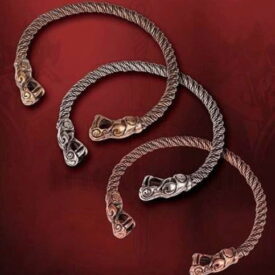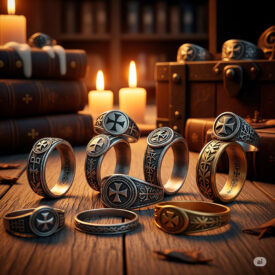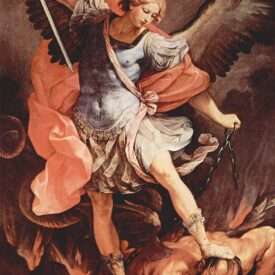An Invisible Thread Between Past and Present
Legend has it that an artisan on an Aegean island first molded a laurel leaf in gold to adorn a priestess’s neck; since then, every pendant with Greek motifs has been a small portable story that unites myth, devotion, and beauty. What secrets do these pieces hide? Why does a motif as simple as a Greek key or a palmette evoke empires, temples, and heroes? This article guides you through the history, techniques, and symbolism of Greek pendants, and helps you understand how to read a replica with a historian’s eye and aesthetic sensitivity.
Chronology of Greek Jewelry
To understand a Greek pendant, it is essential to place it in time. Technical and symbolic evolution can be read in the metals, motifs, and complexity of execution.
| Era / Date | Description and Events |
|---|---|
| Prehistoric and Minoan Origins (Bronze Age) | |
| Minoan | The Greek jewelry tradition dates back to prehistory, with findings in Crete. The first ornaments were simple, but in the Minoan era, metals such as gold, silver, tin, and copper were imported. Jewelry already showed finesse and themes inspired by nature: flowers, bees, and scarabs. |
| Mycenaean Civilization (c. 1600 BC) | |
| Mycenaean | Geometric motifs such as spirals, stars, and crescent moons were incorporated. Swords with rich decorations and golden funerary masks have been found. The use of gold and gems was already common in this era. |
| Geometric Period | |
| Geometric | Characterized by simpler, geometric designs, often with stylized naturalistic representations. |
| Archaic Period (8th-6th centuries BC) | |
| Archaic | A formative era with diverse influences. There was an evolution from geometrism to naturalism. Jewelry from this period shows a predominance of Etruscan influence, highlighting techniques such as granulation. |
| Classical Period (5th-4th centuries BC) | |
| Classical | Artistic and cultural zenith. Personal jewelry tended to be sober, linear, and often lacked precious stones, with mythological figures as recurring themes. Despite their simplicity, they were of exceptional technical finesse. |
| Post-Classical Period (4th century BC) | |
| Post-Classical | After the conquest of Philip of Macedon, a period of pleasure-seeking began, and a taste for luxury and opulence emerged that would be accentuated in the Hellenistic era. |
| Hellenistic Period (Late 4th – 1st centuries BC) | |
| Hellenistic | Alexander the Great’s conquests expanded Greek culture and assimilated Eastern influences. This era was characterized by an exaggeration of luxury, opulence, and polychromy. There was an abundance of gold, and new precious stones were incorporated. |
| Byzantine Empire (10th and 11th centuries) | |
| Byzantine | Greek jewelry reached a peak in variety, imagination, and richness, reflecting the splendor of the imperial court. Both small-scale craftsmanship and liturgical objects were developed. |
| Modern Times (17th-18th and 19th centuries) | |
| Modern | In the 17th and 18th centuries, gold and silversmithing flourished again, with centers dedicated to silver and bronze. The 19th century, with the creation of the Greek State, promoted a revaluation of ancient civilization. |
| From 1950 to the Present | |
| Contemporary | From the mid-20th century, Greek goldsmiths have revitalized jewelry, combining ancient and modern techniques. Contemporary designers such as Nikos Koulis, Lito, and Yannis Sergakis continue to innovate. |
From Jewelry as Amulet to Piece of Prestige
Greek pendants are not mere ornaments: they were born with the intention of protecting, proclaiming identity, and remembering stories. In their simplest form, they were amulets that hung on the chests of children and youth; in their most sumptuous version, they crowned powerful figures and accompanied the funerary trousseau of the elite. This dual nature — practical function and symbolic load — explains why their motifs endure.
Motifs and their Symbolic Reading
- Greek Key / Meander: symbol of continuity, eternity, and order. Its repetition is visual rhythm and a reminder of cycles.
- Palmette and leaves: allude to fertility, nature, and victory when presented as laurels.
- Mythological figures: heroes, gods, and winged beings evoke protection, power, or love (Eros).
- Animals and beast heads: lions, bulls, or eagles represent courage, status, and the relationship between human and divine.
- Knots and protective symbols: patterns like the Heracles knot were used as talismans with connotations of health and good fortune.
Techniques that Make Metal Speak
Behind each pendant is a technical recipe that time has refined. Greek goldsmiths combined ingenuity and patience to create delicate but resistant pieces.
Filigree: twisted and soldered metal threads to create brilliant lace. Granulation: tiny soldered spheres that provide texture and rhythm. Repoussé and chasing: forms that stand out from the metal surface. Lost-wax casting: for more complex volumes. Each technique conveys an intention: the brilliance of filigree suggests refinement; granulation, an almost microscopic precision.
Materials and Palette
Gold was king for its unalterable shine, followed by silver and bronze. Over time, stones arrived: carnelians, amethysts, sapphires, and pearls enriched the palette. But the use of gems was not uniform: in the classical era, moderation prevailed; in Hellenism, opulence unleashed itself.
| Material | Common Use | Meaning or Effect |
|---|---|---|
| Gold | Prestige pieces and funerary trousseau | Divinity, permanence, status |
| Silver | Everyday and religious accessories | Refinement, accessible elegance |
| Bronze | Decorative elements and popular replicas | Durability, connection with daily life |
| Carnelian, amethyst, sapphire | Settings in Hellenistic pendants | Color, symbolic protection, distinction |
How to Read a Replica: Details That Matter
When you observe a pendant inspired by antiquity, you are reading a modern interpretation of the past. There are signs that allow you to distinguish a well-documented replica from a more superficial one.
- Quality of metalwork: look for clean filigree, uniform granulation, and discreet joining points.
- Proportion and scale: classical designs respect symmetry and the relationship between motif and support.
- Patina and finish: a light patina can indicate aesthetic aging; an artificial patina that is too uniform detracts from visual authenticity.
- Motif coherence: vegetable, geometric, or mythical motifs usually correspond to a specific stylistic school; an incoherent mix of symbols can be a symptom of a purely decorative design.
Pendants Inspired by Greek Motifs
In historical reenactment and classic-inspired jewelry, Greek pendants take on very diverse forms: medallions with busts, geometric amulets, miniature shields, and representations of mythological scenes. Each type has its own language that can be read carefully.
The medallion with a human profile, for example, refers to the portrait tradition and the appreciation of the human figure in Greek culture. The disk with a Greek key is an emblem of order and architecture. The small shield or warrior emblem speaks of honor and collective memory.
Comparative Table: Types of Pendants
| Type | Motif | Historical Context |
|---|---|---|
| Medallion with bust | Portrait or deity | From classical era; personal or devotional celebrations |
| Disk with Greek key | Geometric motif | Popular in archaic and classical; symbolism of order |
| Zoomorphic amulet | Animal head or figure | Protective use; frequent in archaic and Mycenaean eras |
| Piece with cameo | Carved in sardonyx | Developed in Hellenism; luxury and distinction |
Conservation and Maintenance: Respecting History
A well-made replica is a bridge to the past; keeping it in good condition allows it to continue telling its story. Avoid abrasive products, store pieces in dry places, and use soft cloths to clean the metal. For plated or patinated pieces, cleaning should be minimal to avoid removing the artisan’s aesthetic intention.
The Cultural Value of Wearing a Symbol
Wearing a pendant with Greek motifs is, in essence, carrying a story. It is to remember that behind every ornament there were hands, rituals, and a way of understanding the world. This emotional connection transforms the piece: it ceases to be an object to become a cultural talisman.
Contemporary Reinterpretations: Tradition and Novelty
Contemporary designers draw from ancient sources without losing dialogue with modernity. They recover motifs and techniques, but apply new scales, alloys, and finishes. This tension between historical fidelity and creative freedom is what keeps the Greek motif alive in current jewelry.
Quick Tips for Identifying Historical Fidelity
- Observe the technique: real filigree and well-executed granulation indicate tradition.
- Assess coherence: a classic motif integrated into a clean composition is better than a collage of symbols.
- Ask about the manufacturing technique: pieces reproduced with traditional methods usually offer a more convincing result.
A Last Glimmer: Words to Carry
When you look at a Greek pendant, remember that you hold the memory of a culture that celebrated form and reason, but also the poetry of myths. A simple motif can contain centuries of meanings; a Greek key can be a map, a knot, an oath. Wearing that piece is, in a way, continuing the story.
VIEW MORE GREEK PENDANTS | VIEW MORE PERIOD PENDANTS | VIEW BEAUTIFUL PERIOD JEWELRY











